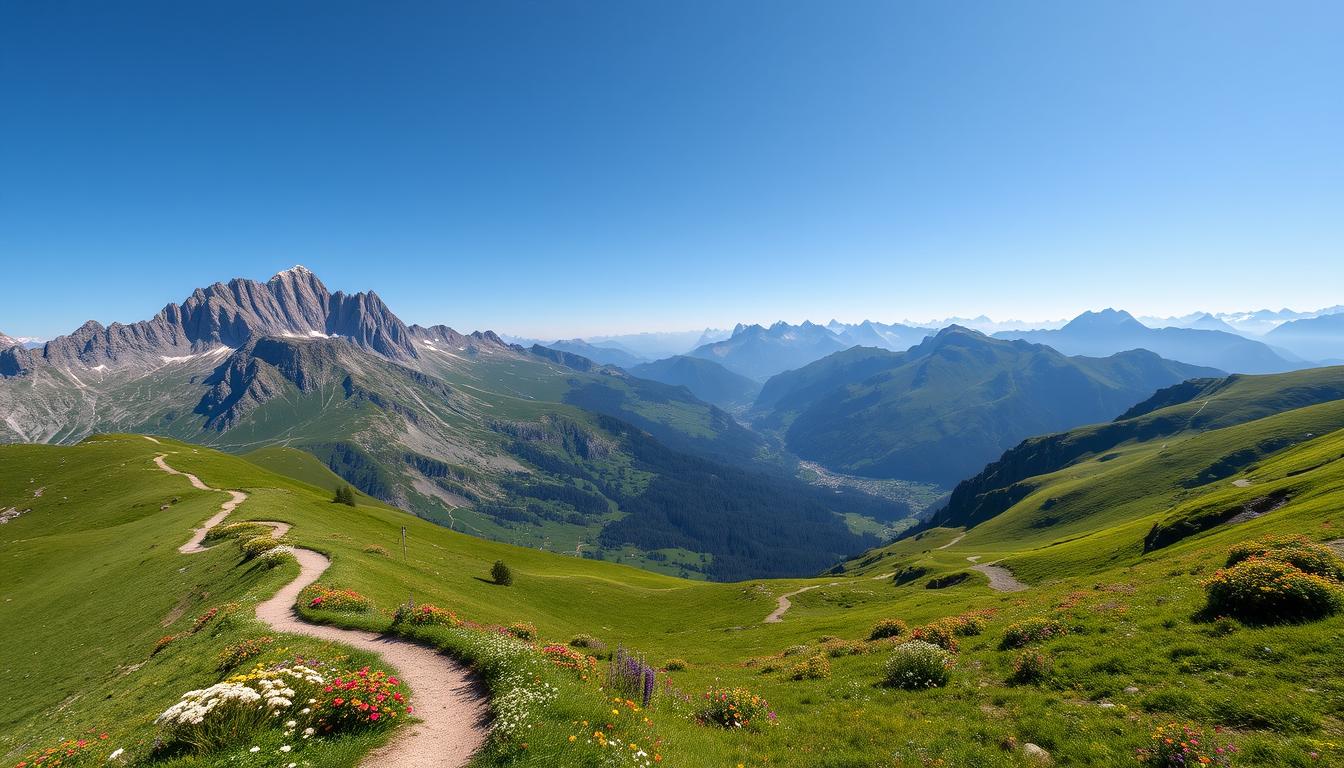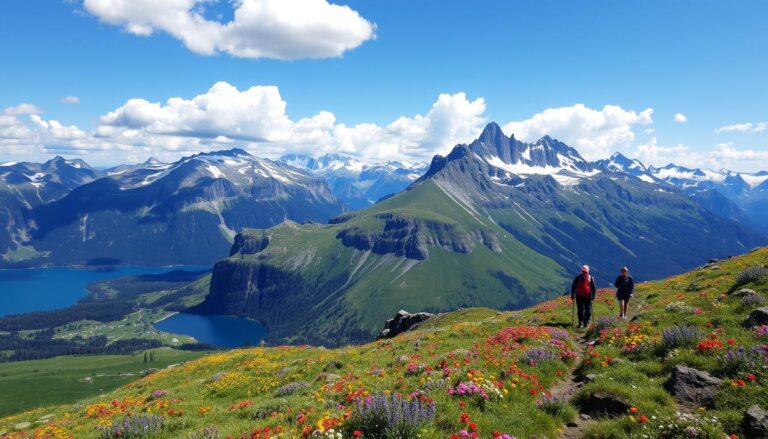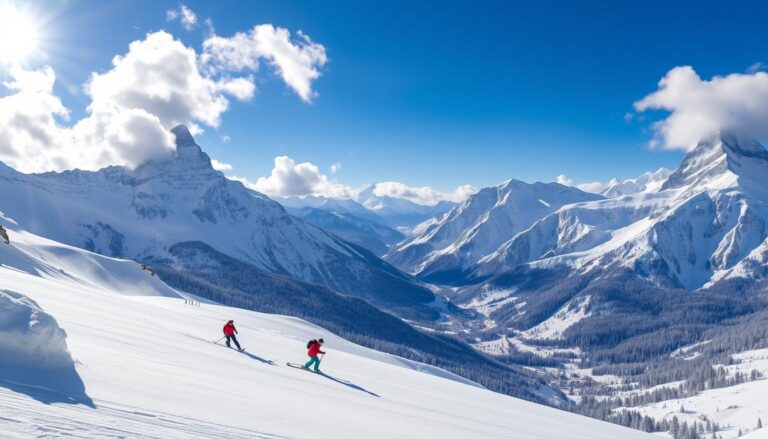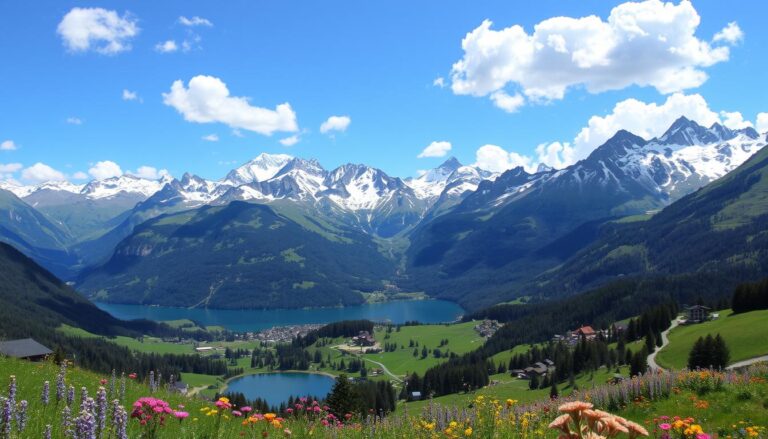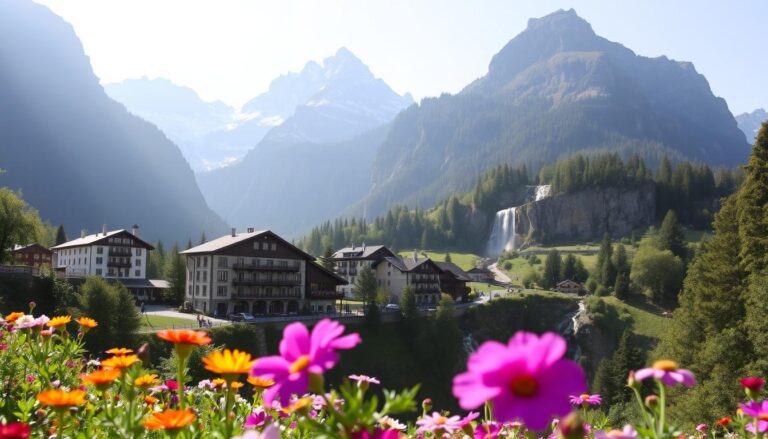Hiking in Switzerland: Discover the Country’s Top Trails
Imagine standing on a Swiss mountain trail, feeling the crisp air fill your lungs. Around you, breathtaking views stretch far and wide. Switzerland is home to some of the world’s best hikes, with trails covering 62,500 kilometers. That’s enough to circle the globe 1.5 times.
The Swiss landscape is a call to adventure for all. It offers everything from towering Alps to calm valleys and clear lakes. Top hiking trails in Switzerland promise an unmatched outdoor adventure. Whether you’re an experienced trekker or just starting out, there’s something special for everyone.
September is the best time to hike in Switzerland. The weather is perfect, around 75 degrees Fahrenheit, and mountain huts are still open. The Jungfrau Region is a highlight, with its stunning landscapes that make your hike unforgettable.
Every trail in Switzerland has its own story to tell. They challenge you but reward you with views that look like they’re from a postcard. The Eiger Ultra Trail is a prime example, showcasing the Swiss Alps’ beauty and history.
Get ready to see why Switzerland is a paradise for hikers. Every step reveals a new wonder, and every trail offers an epic adventure.
Table of Contents
Introduction to Hiking in Switzerland
Switzerland is a magical place for hiking. A guide shows a world where trails meet stunning alpine views. It’s a unique adventure for those who love the outdoors.
Hiking in Switzerland is more than fun—it’s a tradition. The Swiss see hiking as a key part of their culture. It brings families together as they explore nature.
Overview of Swiss Hiking Culture
Swiss hiking culture has special features:
- Extensive network of well-marked trails called “wanderweg”
- National commitment to outdoor recreation
- Robust trail infrastructure across diverse terrain
- Integration of hiking into daily lifestyle and health practices
“In Switzerland, hiking is not just a pastime—it’s a way of life.”
The country has great hiking spots thanks to its infrastructure. With over 65,000 kilometers of trails, there’s something for everyone. From easy walks to tough climbs, Switzerland has it all.
Popularity of Hiking in the U.S.
More Americans are visiting Switzerland for hiking. The beauty, trails, and culture draw them in. It’s a favorite spot for U.S. adventurers.
| Hiking Route | Length | Difficulty |
|---|---|---|
| Via Alpina | 390 kilometers | Moderate to Challenging |
| Bärentrek | Crosses 8 Alpine passes | Advanced |
| Kesch Trek | 4-6 days | Intermediate |
Switzerland’s hiking trails offer something for every skill level and adventurous spirit.
Best Hiking Regions in Switzerland
Switzerland has an amazing network of hiking trails. These trails go through some of the most stunning landscapes in the world. With over 10,652 hiking routes in Eastern Switzerland, hikers can find everything from easy valleys to tough mountain paths.
Switzerland’s hiking spots are perfect for outdoor lovers. The country’s trails are well-marked, making it easy and fun for everyone to explore.
The Swiss Alps: Mountain Trail Paradise
The Swiss Alps are the top choice for mountain trails in Switzerland. These mountains offer a wide range of hiking experiences. They challenge and inspire all kinds of adventurers.
- Stunning alpine landscapes
- Elevation ranges from 1,000 to 4,000 meters
- Variety of trail difficulty levels
The Jura Mountains: Serene Alternative
The Jura Mountains are great for those who want quieter trails. They have rolling hills and dense forests. These trails give you amazing views and a unique look at Swiss nature.
The Engadin Valley: Alpine Gem
The Engadin Valley is in Graubünden and is known for its untouched beauty. It has pristine landscapes, traditional villages, and is close to the Swiss National Park. This area shows Switzerland’s true natural beauty.
| Region | Total Hikes | Average Rating | Difficulty |
|---|---|---|---|
| Swiss Alps | 5,326 | 4.8/5 | Moderate to Challenging |
| Jura Mountains | 2,785 | 4.6/5 | Easy to Moderate |
| Engadin Valley | 2,541 | 4.7/5 | Easy to Intermediate |
“The Swiss landscape is a treasure trove of hiking experiences waiting to be discovered.” – Swiss Alpine Club
Each region has its own special trails. They meet different tastes, making Switzerland a top spot for hiking adventures.
Iconic Trails to Explore
Switzerland is home to some of the most stunning alpine hiking trails. The country’s vast network of trails lets hikers see breathtaking mountain views. From tough alpine paths to beautiful scenic routes, these hikes show off Switzerland’s natural beauty and geological wonders.
The Matterhorn Trail: A Legendary Alpine Experience
Zermatt’s famous Matterhorn draws hikers from all over. The Hornliweg trail is a must-see for its amazing mountain views. Here are some key facts:
- Distance: 4.3 km round trip
- Hiking Time: Approximately 2 hours
- Altitude Gain: 743 meters
The Aletsch Glacier Trail: A UNESCO World Heritage Journey
Explore Europe’s biggest glacier on an unforgettable hike. The Aletsch Glacier Trail is a unique way to see this natural wonder:
- Glacier Length: 23 km
- Hike Distance: 17 km one way
- Hiking Duration: Approximately 6 hours
- Glacier Depth: Around 900 meters
“Walking the Aletsch Glacier is like stepping into a frozen world of extraordinary beauty and geological significance.” – Swiss Alpine Club
The Eiger Trail: Challenging Mountain Exploration
The Eiger Trail is a top choice for Swiss hiking. It’s near the famous North Face and offers breathtaking views and tough terrain:
- Trail Distance: 6 km
- Hiking Time: Approximately 2.5 hours
- Altitude Loss: 800 meters
- Mountain Height: Nearly 4,000 meters
These iconic trails are the best of Swiss alpine hiking. They give hikers a chance to see some of the world’s most stunning mountains.
Family-Friendly Hikes
Switzerland is a paradise for families who love the outdoors. Its trails are well-kept and the views are stunning. This guide helps families find hikes that are fun for kids.
Family hikes in Switzerland are a mix of nature and easy paths. They are great for kids aged 5 and up. These hikes are usually 3 to 7 kilometers long.
The Five Lakes Walk
The Five Lakes Walk in Zermatt is unforgettable. It has:
- Moderate difficulty level
- Spectacular views of the Matterhorn
- Five picturesque mountain lakes
- Approximately 4-5 kilometers in length
The Panorama Trail
The Panorama Trail in the Jungfrau region is perfect for families. It offers:
- Gradual ascents and descents
- Sweeping mountain vistas
- Accessible terrain for children
- Proximity to amenities
The Tarasp Castle Trail
The Tarasp Castle Trail in Lower Engadine is special. It combines history with nature. Families can see:
- Historical castle exploration
- Diverse landscape views
- Relatively easy walking path
- Interesting cultural insights
“Hiking in Switzerland is not just a walk, it’s a journey through breathtaking landscapes and family memories.” – Swiss Tourism Board
These trails show why Switzerland is a top spot for family hikes. They offer scenic views and easy paths for everyone.
Challenging Hikes for Adventurers
For those who love hiking, Switzerland has some of the toughest trails. These routes test your strength and willpower. They offer stunning views and unforgettable experiences.
The Haute Route: An Alpine Challenge
The Haute Route is the ultimate challenge in Switzerland. It’s a long hike from Chamonix, France, to Zermatt, Switzerland. You’ll cross 11 mountain passes, seeing some of Europe’s most beautiful landscapes.
- Total distance: 180 kilometers (112 miles)
- Elevation gains: Significant and demanding
- Typical duration: 10-14 days
- Difficulty level: Advanced
“The Haute Route is not just a hike, it’s an alpine adventure that challenges your limits and rewards you with unparalleled mountain scenery.” – Alpine Hiking Experts
Schynige Platte to First Trail: A Dramatic Ridge Walk
The Schynige Platte to First trail is a must-try for adventurers. It’s a tough day hike in the Bernese Oberland. You’ll see amazing views of the mountains.
| Trail Details | Specifications |
|---|---|
| Distance | 6-7 kilometers |
| Elevation Gain | Approximately 500 meters |
| Difficulty | Advanced |
| Best Season | June to September |
Make sure you’re in good shape and have the right gear. The trail has steep parts and narrow paths. You’ll need good fitness and experience.
Both trails need careful planning, the right equipment, and lots of physical fitness. Always check the trail conditions and think about getting a guide for these tough hikes.
Scenic Views: Best Photo Spots
Switzerland is a paradise for photographers. Its top hiking trails show off stunning views of the Alps. You can see everything from towering mountains to peaceful valleys, making it perfect for amazing photos.
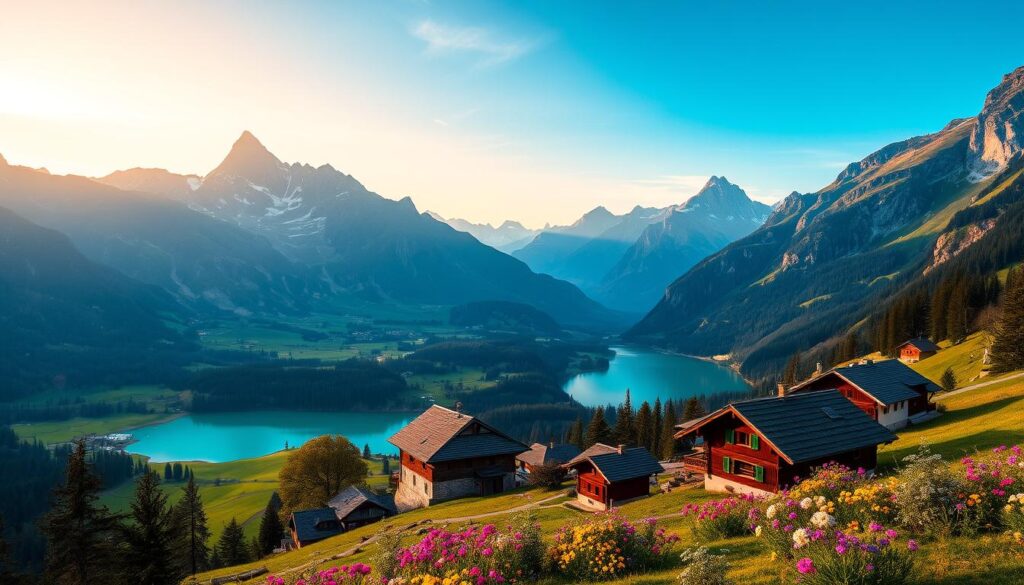
Top Lookout Points on Trails
Finding the best spots for photos on Switzerland’s trails takes some planning. Here are some standout views:
- Eiger Trail: Offers panoramic views of Eiger, Mönch, and Jungfrau mountains
- Rigi Panorama Trail: Provides 360-degree Alpine vistas
- Lauterbrunnen Valley: Captures stunning waterfall and mountain perspectives
Tips for Capturing the Swiss Landscape
Experts say there are certain ways to take great photos of Switzerland’s mountains:
- Use a 24-70mm lens for comprehensive landscape shots
- Plan photography during golden hours (sunrise and sunset)
- Capture unique seasonal perspectives
“The Swiss landscape is not just a view, it’s a masterpiece waiting to be captured.” – Alpine Photography Expert
| Location | Best Photography Season | Recommended Time |
|---|---|---|
| Stanserhorn | Autumn to Early Spring | Sunrise/Sunset |
| Staubbachfall | Late May to Early July | Morning Hours |
| Lauterbrunnen Valley | Summer | Late Afternoon |
Knowing about lighting, terrain, and timing can turn hikes into stunning photo stories. This way, you can capture the beauty of Switzerland’s landscapes.
Seasonal Hiking in Switzerland
Switzerland offers an incredible hiking experience that changes with each season. Knowing the differences in seasonal hiking helps plan the perfect adventure all year.
The alpine landscape offers unique hiking opportunities in different seasons. Each season adds its own magic to the trails.
Spring Hiking Tips
Spring hiking in Switzerland needs careful planning. Mountain transport opens in mid-May, and trails become accessible by late June. Early season hikers can enjoy:
- Lower altitude trails with milder terrain
- Wildflower-rich meadows
- Trails with moderate elevation gains
Recommended spring hikes include:
- Lauterbrunnen Valley Walk (6.7 km, 1.5-2 hours)
- Seerenbachfälle Trail (18.5 km, 4 hours)
- Pfannenstiel Trail (12 km, 3 hours)
Summer Trails to Consider
Summer is the peak hiking season in Switzerland. High-altitude routes offer breathtaking views and extensive trails.
“The Swiss mountains reveal their true beauty during summer months” – Swiss Alpine Club
Peak season trails include:
- Morteratsch Glacier Trail (6 km, 2 hours)
- Lake Cavloc Loop (7 km, 2 hours)
- Braunwald Trail (9 km, 3.5 hours)
Hiking in Autumn Colors
Autumn offers a spectacular backdrop for hiking in Switzerland. Fall foliage peaks in the second half of October, creating stunning landscapes.
Notable autumn hiking routes:
- Val Trupchen Trail (14.2 km, 4 hours)
- Seealpsee Trail (5.5 km, 2 hours)
- Atzmännig Descent (6.9 km, 2.5 hours)
Hikers should prepare for earlier sunsets and potentially challenging visibility during evening autumn hikes.
Essential Gear for Swiss Hiking
Getting ready for hiking in Switzerland means planning well and choosing the right gear. The Swiss Alps are tough, so you need special hiking equipment. This ensures you stay safe and comfortable on the trails.
When you start a hiking adventure in Switzerland, picking the right clothes and gear is key. It can greatly improve your mountain experience.
Clothing Essentials for Alpine Hiking
For successful hiking in Switzerland, layering is crucial. Here are the must-have clothing items:
- 2-3 moisture-wicking T-shirts
- Insulating mid-layers
- Waterproof outer jacket
- Quick-drying hiking shorts or leggings
- 3 pairs of moisture-wicking socks
“The right clothing can transform a challenging hike into an unforgettable mountain experience.” – Swiss Alpine Club
Navigation and Safety Tools
Today’s hikers have many ways to navigate trails during their Swiss hiking adventures:
- Physical topographic maps
- Compass for traditional navigation
- GPS-enabled hiking apps
- Offline map downloads
Don’t forget these essential items:
- Lightweight backpack (45-55 liter capacity)
- Minimum 1.5 liters of water
- Multi-tool or Swiss Army knife
- First aid kit with basic medical supplies
- Sun protection (hat, sunglasses, sunscreen)
Pro tip: Always check the weather and trail difficulty before your Swiss hiking adventure.
How to Prepare for a Hike
Getting ready for hiking in Switzerland means planning well. You need to know about your physical fitness and the weather. The Swiss Alps have amazing trails that require the right preparation for a safe and fun trip.
Physical Fitness Recommendations
Preparing for your Swiss hiking adventure starts with getting fit. Here are some important tips:
- Build your heart health by hiking, walking, or cycling often
- Work on your leg strength with squats and lunges
- Practice hiking with a heavy backpack to get used to the trail
- Do exercises that improve your core and balance for mountain paths
Understanding Swiss Weather
The weather in the Alps can shift quickly. To hike successfully in Switzerland, you must be ready for anything:
| Weather Factor | Preparation Strategy |
|---|---|
| Temperature Variations | Wear layers, bring clothes that can be changed |
| Precipitation Risk | Bring a waterproof jacket, wear quick-dry clothes |
| High-Altitude Conditions | Check the forecast, carry emergency supplies |
“In the mountains, weather is not just a forecast—it’s a living condition that demands respect and preparation.”
It’s key to be ready for emergencies. Carry important phone numbers and a reliable first-aid app for your Swiss hiking trip.
Guided vs. Solo Hiking Experiences
Alpine hiking adventures come in two forms: guided and solo. Each offers a unique way to enjoy Switzerland’s stunning landscapes.
Benefits of Guided Hikes
Guided hikes have many perks for those looking for a structured adventure:
- Expert knowledge of local terrain and ecology
- Enhanced safety for less experienced hikers
- Cultural insights from professional guides
- Structured itineraries with planned routes
“A good guide transforms a simple walk into an unforgettable journey through the Swiss Alps.”
Advantages of Hiking Alone
Going solo in Switzerland offers unique benefits for personal exploration:
- Complete flexibility in route and pace
- Lower travel expenses
- Opportunity for personal reflection
- Sense of personal achievement
Interesting stats show the satisfaction levels of hikers. Self-guided hikers are 85% satisfied, while guided tour participants are 90% satisfied. Guided groups finish routes in 10-12 days. Solo hikers might take 7-14 days, depending on their pace.
Whether to go guided or solo depends on your skill level, comfort, and what you want to experience. Both ways offer amazing chances to see Switzerland’s beautiful alpine landscapes.
Safety Tips for Hiking in Switzerland
Exploring Switzerland’s mountains requires careful planning and awareness. The country’s stunning landscapes come with unique challenges. Hikers need to be prepared to ensure a safe and fun trip.
Preparing for a hike in Switzerland involves several key safety steps:
- Carry essential emergency communication devices
- Understand local mountain rescue protocols
- Pack appropriate safety gear
- Check weather conditions before departure
Navigating Swiss Terrain Safely
Swiss trails need special navigation skills. It’s wise to carry detailed maps and know the trail’s difficulty. Knowing your personal fitness level helps choose the right route for you.
Emergency Preparedness Strategies
Being ready for emergencies is crucial:
| Emergency Resource | Contact Number | Purpose |
|---|---|---|
| General Emergency | 112 | Immediate Assistance |
| Mountain Rescue | 144 | Medical Support |
| Police | 117 | Safety Interventions |
“Preparation transforms potential risks into manageable adventures.” – Swiss Alpine Club
Always put your safety first when hiking in the Alps. Knowing the terrain, carrying the right gear, and staying in touch can make your journey unforgettable.
Conclusion: The Allure of Swiss Hiking
Switzerland offers a unique hiking experience that draws adventurers worldwide. The best hikes in Switzerland combine stunning views, well-kept trails, and rich culture. This makes hiking holidays in Switzerland unforgettable. You’ll see everything from the Swiss Alps’ dramatic peaks to the calm valleys of the Bernese Oberland.
When planning your Swiss hiking trip, think about the seasons. June is when most trails open, and wildflowers are in full bloom. For the brave, there’s the Via Alpina, a 390 km journey through the Swiss Alps. For those who prefer it easier, try the Five Lakes Walk or the Panorama Trail near Engelberg.
Getting ready for your hike is crucial. Look for local advice, pack the right gear, and watch the weather. The varied landscapes require respect and planning. From the Matterhorn Glacier Trail to Interlaken’s scenic paths, each step connects you with Switzerland’s natural beauty.
Your Swiss hiking adventure is more than just exploring. It’s a chance to dive into breathtaking landscapes, test your limits, and make memories that last. Whether you’re after adventure or peace, Switzerland’s trails are ready to be discovered. They promise an outdoor experience that goes beyond what you expect from travel.
Get Ready for Your Alpine Adventure
Start looking into trails, book guided tours, and get ready for an amazing journey. Your Swiss hiking dream is just a few steps away.

